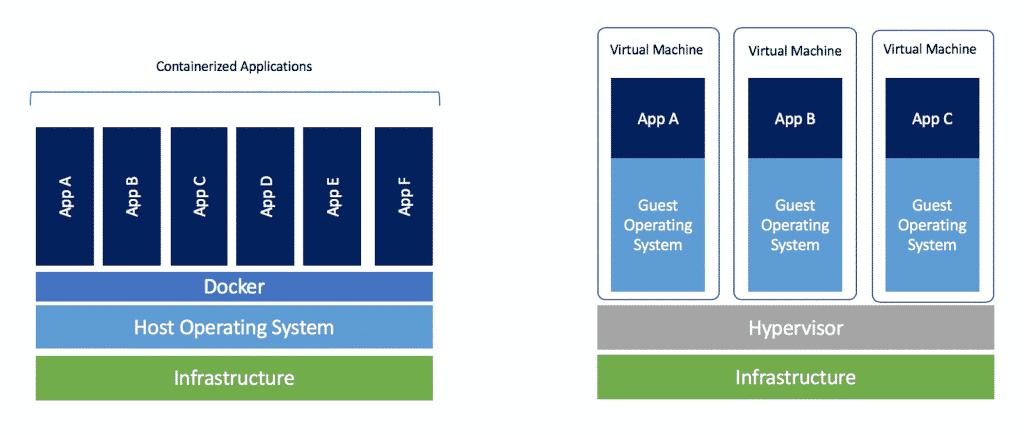Virtual Machines and Containers
Virtual Machines
Virtual machines are simulated computers. You can configure a guest virtual machine with some operating system and configuration and use it without affecting your host environment.
For this class, you can use VMs to experiment with operating systems, software, and configurations without risk: you won’t affect your primary development environment.
In general, VMs have lots of uses. They are commonly used for running software that only runs on a certain operating system (e.g. using a Windows VM on Linux to run Windows-specific software). They are often used for experimenting with potentially malicious software.
Useful features
-
Isolation: hypervisors do a pretty good job of isolating the guest from the host, so you can use VMs to run buggy or untrusted software reasonably safely.
-
Snapshots: you can take “snapshots” of your virtual machine, capturing the entire machine state (disk, memory, etc.), make changes to your machine, and then restore to an earlier state. This is useful for testing out potentially destructive actions, among other things.
Disadvantages
Virtual machines are generally slower than running on bare metal, so they may be unsuitable for certain applications.
Setup
-
Resources: shared with host machine; be aware of this when allocating physical resources.
-
Networking: many options, default NAT should work fine for most use cases.
-
Guest addons: many hypervisors can install software in the guest to enable nicer integration with host system. You should use this if you can.
Resources
- Hypervisors
- VirtualBox (open-source)
- Virt-manager (open-source, manages KVM virtual machines and LXC containers)
- VMWare (commercial, available from IS&T for MIT students)
If you are already familiar with popular hypervisors/VMs you may want to learn more about how to do this from a command line friendly way. One option is the libvirt toolkit which allows you to manage multiple different virtualization providers/hypervisors.
Exercises
-
Download and install a hypervisor.
-
Create a new virtual machine and install a Linux distribution (e.g. Debian).
-
Experiment with snapshots. Try things that you’ve always wanted to try, like running
sudo rm -rf --no-preserve-root /, and see if you can recover easily. -
Read what a fork-bomb (
:(){ :|:& };:) is and run it on the VM to see that the resource isolation (CPU, Memory, &c) works. -
Install guest addons and experiment with different windowing modes, file sharing, and other features.
Containers
Virtual Machines are relatively heavy-weight; what if you want to spin up machines in an automated fashion? Enter containers!
- Amazon Firecracker
- Docker
- rkt
- lxc
Containers are mostly just an assembly of various Linux security features, like virtual file system, virtual network interfaces, chroots, virtual memory tricks, and the like, that together give the appearance of virtualization.
Not quite as secure or isolated as a VM, but pretty close and getting better. Usually higher performance, and much faster to start, but not always.
The performance boost comes from the fact that unlike VMs which run an entire copy of the operating system, containers share the linux kernel with the host. However note that if you are running linux containers on Windows/macOS a Linux VM will need to be active as a middle layer between the two.
 Comparison between Docker containers and Virtual Machines. Credit: blog.docker.com
Comparison between Docker containers and Virtual Machines. Credit: blog.docker.com
Containers are handy for when you want to run an automated task in a standardized setup:
- Build systems
- Development environments
- Pre-packaged servers
- Running untrusted programs
- Grading student submissions
- (Some) cloud computing
- Continuous integration
- Travis CI
- GitHub Actions
Moreover, container software like Docker has also been extensively used as a solution for dependency hell. If a machine needs to be running many services with conflicting dependencies they can be isolated using containers.
Usually, you write a file that defines how to construct your container. You start with some minimal base image (like Alpine Linux), and then a list of commands to run to set up the environment you want (install packages, copy files, build stuff, write config files, etc.). Normally, there’s also a way to specify any external ports that should be available, and an entrypoint that dictates what command should be run when the container is started (like a grading script).
In a similar fashion to code repository websites (like GitHub) there are some container repository websites (like DockerHub)where many software services have prebuilt images that one can easily deploy.
Exercises
-
Choose a container software (Docker, LXC, …) and install a simple Linux image. Try SSHing into it.
-
Search and download a prebuilt container image for a popular web server (nginx, apache, …)
Licensed under CC BY-NC-SA.